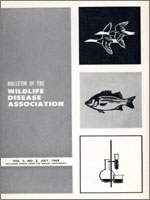Wildlife rabies invaded Ontario in 1954 along the coasts of Hudson and James Bays. During the period 1954 to 1958, rabies was carried into southern Ontario by red foxes (Vulpes vulpes), and in 1958–59 a severe epizootic of rabies occurred. From 1961 to 1969 rabies has remained endemic in southern Ontario. The red fox and striped skunk (Mephitis mephitis) are the main wildlife vectors, and account for 43% and 16% of the total rabies cases respectively. Of the domestic species, cattle make up 22%, dogs 7%, and cats 5%. The remaining 7% are in several other wild and domestic species. An annual cycle of rabies occurs each year, with a peak in December and a low in June. Three year cycles of red fox rabies occur in areas of good red fox habitat. During the initiation of the fall-winter rabies peak, the red fox is the species most commonly involved.
Because of the importance of the red fox as a rabies vector, a sample of 244 rabid red fox heads was collected over a one year period to study the sex-age structure of the rabid population. Animals were sexed by the sex chromatin technique and aged by counting tooth cementum layers. Forty percent of the heads showed evidence of ferocious contact as indicated by bites or cuts. Females showed a significantly higher rate of ferocious contact in March during the time of parturition. Animals from high rabies areas showed significantly more evidence of ferocious contact than did animals from areas of isolated cases. Thirty-four percent of the rabid red foxes had attacked porcupines (Erethizon dorsatum) as evidenced by porcupine quills in their muzzles. This species is usually avoided by normal red foxes.
During the increase in rabies in late summer and early fall, juvenile males were the predominant sex-age class in the rabid sample. This increase in rabies corresponds to the time of dispersal and reproductive maturation in juvenile males.
The peak of red fox rabies is in March. Yearling females were the most common sex-age class during this time, which also corresponds to the time of parturition. The oldest rabid red foxes were 4 years old. The results of the study indicate apparent relationships between the susceptibility of red foxes to rabies and various physiological changes which occur at different times of the year.





